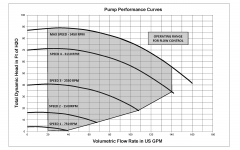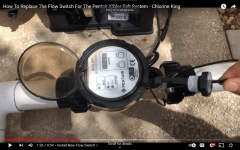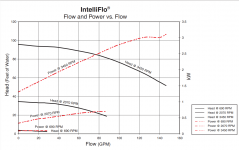- May 10, 2022
- 42
- Pool Size
- 20000
- Surface
- Plaster
- Chlorine
- Salt Water Generator
- SWG Type
- Pentair iChlor 30
The VF pumps use RPM and Watts to determine the flow rate. These three variables (RPM, GPM, Watts) are unique at each value so are fairly accurate (~10%).
The VSF pump does not have a flow meter. The flow is calculated based on the power the motor draws. It is an approximation at best.
I don't mean to bring up an old thread, but the question I was about to post is similar to this topic.
I want to somewhat challenge/question what was said above. I've noticed, using the Pentair VSF readout, that there is definitely not a clear relationship between GPM, RPM and Watts (in other words, I'm not confident it's using an equation based on RPM and Watts).
For instance, I have found that I can run something like 700 RPM at 35 watts, with a 25GPM output.
On the other hand, if I increase to 1000 RPM, watts go up to 80, however GPM is about 23-24 (likely some small turbulence).
This is a simple example, but the trend continues. I can also play around with my valves to some degree to adjust GPM, but with no real change in watts or RPM. If there wasn't a flow meter, and if watts and RPM weren't changing, there isn't a way it would know that GPM was getting 'more efficient' (flowing more) when I open up additional valves.
This tells me that the pump must have SOME form of flow meter?
What's also interesting is, I've found that, once you go below say 600 RPM, watts go back UP a bit (to about 120 watts) to maintain the same GPM. This tells me that the motor is now working 'harder' to maintain that low RPM vs its 'happy place' at say that 750rpm mark. Because GPM doesn't go up in relation to that 120 watt reading, this further tells me that an equation isn't being used.
Now THAT said, I DO have an iChlor30. Is there a chance that, when using that device, it references what that unit is saying, in place of the 'calculated gpm' referenced above? I'm not convinced this is the case as I'm fairly sure I witnessed the same GPM/Watt dynamic prior to installing the iChlor, but can't say with 100% certainty.
Actually now that I think of it, I don't think the iChlor matters. Just read a thread where someone has the same pump, turning 3000 RPMS, 1300 watts but showing only 40GPM. I run closer to 70GPM at that rpm/wattage. If it really WAS using a calculation, our GPM numbers would match 100%.
So the question remains, how is the Pentair VSF getting its GPM reading, and has anyone compared this to an external flow meter?
Last edited:




